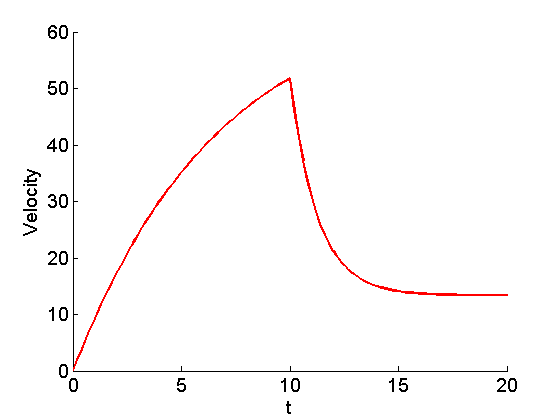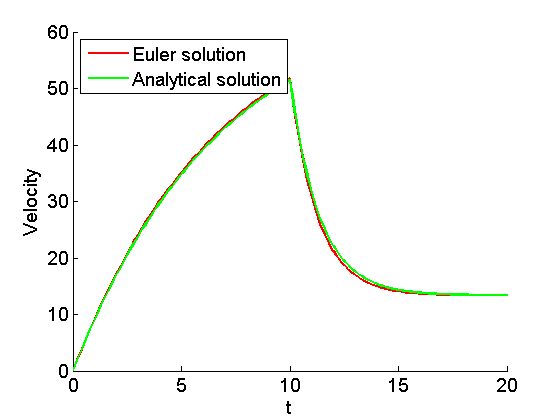SkydiveChuteDemo.m
Contents
Overview
This script illustrates the solution of a first-order IVP:

where  if
if  and
and  for
for  .
.
The analytical solution is


for finding the velocity of a skydiver when his parachute opens midflight. Here  stands for time,
stands for time,  for velocity, and
for velocity, and
 : gravitational constant
: gravitational constant : mass
: mass : (time dependent) drag coefficient
: (time dependent) drag coefficient
The analytical solution is coded in VelocityChute.m and the right-hand side function is coded in SkydiveChute.m
The Main Function
function SkydiveChuteDemo()
% Note that you cannot include other functions inside a *script*, but if % you turn your main script into a *function*, then you can do it (see % below).
Initialization
clear all clc close all g = 9.81; m = 68.1; c1 = 10; c2 = 50; % specific constants v = @VelocityChute; % analytical solution f = @SkydiveChute; % function handle for right-hand side function t0 = 0; y0 = 0; % initial time and initial velocity tend = 20; % end time N = 100; % number of time steps h = (tend-t0)/N; % stepsize
Call Euler
We will discuss this function later
[t,y] = Euler(t0,y0,f,h,N);
Plot
figure hold on set(gca,'Fontsize',14) xlabel('t','FontSize',14); ylabel('Velocity','FontSize',14); plot(t,y,'r','LineWidth',2); % Euler solution

tt=linspace(t0,tend,201); plot(tt,v(tt),'g','LineWidth',2); % analytical solution legend('Euler solution','Analytical solution','Location','NorthWest'); hold off fprintf('Final velocity: %f m/s.', g*m/c2)

end
The VelocityChute Function
function v = VelocityChute(t) % v = VelocityChute(t) % t (time) is a vector of times at which we want to evaluate the analytical % solution. % % v (velocity) is a vector with values of the analytical function. % % Note how we use *logical vectors* below to distinguish between the two % cases (before and after the chute opens at time T). % % The following parameters are rough estimates g = 9.81; % gravitational constant (in m/s^2) c1 = 10; % drag coefficient (in kg/s) c2 = 50; % drag coefficient (in kg/s) m = 68.1; % mass of skydiver (in kg) T = 10; % time the chute opens v1 = (g*m/c1 * (1-exp(-c1/m*t))); % velocity if t < T v2 = (g*m/c2 - g*m/(c1*c2) * exp(-c2/m*(t-T)) .* (c1-c2+c2*exp(-c1/m*T))); % velocity if t >= T v = v1 .* (t<T) + v2 .* (t>=T); % multiplication by logical vectors here end
Final velocity: 13.361220 m/s.
The SkydiveChute Function
function yprime = SkydiveChute(t,y) % yprime = Skydive(t,y) % t (time) and y (velocity v(t)) are scalars. % % yprime is the derivative of y at time t. % % The following parameters are rough estimates g = 9.81; % gravitational constant (in m/s^2) c1 = 10; % drag coefficient (in kg/s) c2 = 50; % drag coefficient (in kg/s) m = 68.1; % mass of skydiver (in kg) T = 10; % time the chute opens if t < T yprime = g - (c1/m)*y ; else yprime = g - (c2/m)*y ; end end